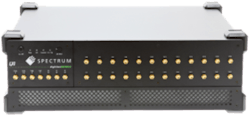Spectrum’s AWGs offer up to 24 fully synchronous channels
Grosshansdorf, Germany. Advanced electronic systems are increasingly turning to parallel design architecture to increase their overall performance in applications such as MIMO, radar, quantum computing, and multilane serial bus testing. To develop these systems, and those with similar multireceiver/emitter or multisensor technology, it is helpful to have the ability to generate multiple synchronized waveforms. Fast arbitrary waveform generators (AWGs) have become the instruments of choice as they allow easy and flexible signal generation. However, most high-performance AWGs only provide a limited channel count (one to four), which can make creating larger test systems quite expensive. In addition, these AWGs face serious problems when systems are scaled up for higher channel count applications as they typically present numerous synchronization issues. Spectrum’s DN6.66xx series of AWGs overcomes these challenges by offering up to 24 fully synchronized channels. The series allows engineers to select from an extensive range of products that are cost-effective and specifically designed for multichannel, signal-generation applications.
Importantly for most applications, all the output channels are clocked and triggered synchronously so they maintain a constant, interchannel clock-phase relationship. The clocking system uses a precision PLL control process that can be generated internally or, alternatively, from an external clock or reference. Time skew between the channels is also minimized with the maximum skew, between all channels, being less than 130 ps.
Advanced waveform replay modes
To allow the generation of long and complex waveforms, the AWGs combine their very large on-board memories with a number of operating modes such as Single-Shot, Loop, FIFO, Gating, and Sequence Replay. Sequence Mode cuts the memory into segments of different length and combines them with a sequence of commands including loops for more efficient memory use.
For further system flexibility, front-panel multipurpose I/O connectors provide access to multiple marker outputs, asynchronous digital inputs, asynchronous digital outputs, the trigger output, the run and arm status, and the PLL reference clock.
The instruments are fully self-contained and come with all the tools necessary to generate an almost unlimited variety of waveforms. Simply connect the unit to a host computer (for example, a laptop or workstation) or anywhere on the corporate network and start up Spectrum’s SBench6-Pro software. SBench6-Pro comes as standard with every unit. It lets the user control all of the AWG’s operating modes and hardware settings from one simple, easy-to-use, graphical user interface. The software also has a host of built-in features for waveform creation, data analysis, and documentation. These include an EasyGenerator function (for producing standard wave shapes such as sine, rectangular, triangle, saw-tooth, SINC, and DC), equation-based waveform creation (for complex modulated waveforms), and full import/export capability for data transfer between other devices (such as digitizers and oscilloscopes) or software programs like MATLAB or LabVIEW. SBench6 also supports most popular data formats including ASCII, binary and WAV.
Extensive software support
So that the generatorNETBOX units can be quickly integrated into a new test system, a comprehensive software development kit (SDK) is provided with drivers and support examples. The SDK allows programming with almost any popular language including C++, Visual Basic, VB.NET, C#, J#, Delphi, Java and Python. Third party software support and examples are also available, free of charge, for LabVIEW, LabWindows and MATLAB.
For applications where a generatorNETBOX needs to operate remotely, Spectrum offers an embedded server option, DN6.xxx-Emb. This option combines a CPU, a freely accessible SSD, more memory, and a remote software development access method. The embedded server option creates an open platform where users can run their own software while, at the time, still being connected via LAN for remote access. The option effectively allows the generatorNETBOX to operate independently or, when connected to a LAN, as part of a larger test system.
About the Author

Rick Nelson
Contributing Editor
Rick is currently Contributing Technical Editor. He was Executive Editor for EE in 2011-2018. Previously he served on several publications, including EDN and Vision Systems Design, and has received awards for signed editorials from the American Society of Business Publication Editors. He began as a design engineer at General Electric and Litton Industries and earned a BSEE degree from Penn State.

